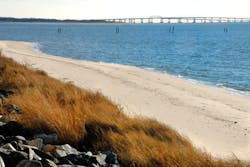USDA provides $4 million to improve Chesapeake Bay water quality
The U.S. Department of Agriculture (USDA) has announced new funding to help improve water quality in the Chesapeake Bay, according to a press release.
USDA Under Secretary for Farm and Foreign Agricultural Services Michael Scuse said that the agency has committed $4 million to the states of Delaware, New York, Virginia and West Virginia under its Conservation Reserve Enhancement Program (CREP), which aims to increase or maintain land enrolled in Chesapeake Bay Riparian Forest Buffer conservation.
The funding announced on Thursday will help agricultural landowners accelerate stream and riverbank tree plantings that can reduce soil sedimentation, field and animal waste runoff.
In addition, Farm Service Agency offices in Maryland and Pennsylvania will receive support to partner with stakeholders for improved outreach and technical assistance.
“The 2014 Farm Bill has enabled USDA to support expanded conservation practices on crop, pasture and private forestland in the bay,” commented Robert Bonnie, USDA Under Secretary for Natural Resources and Environment in the release.
“Working with our partners, including farmers, nonprofit and private organizations, local and state governments, and individuals, we are leveraging federal dollars to reduce nutrient and sediment losses. This would not be possible without the voluntary efforts of land owners and widespread public support.”
Supplementing the federal funds, a state funding match of 20 percent will be used to conduct more environmental studies to expand eligible counties, improve outreach and educational efforts, and provide higher financial incentives to encourage more agricultural landowners to participate in the tree restoration efforts.
